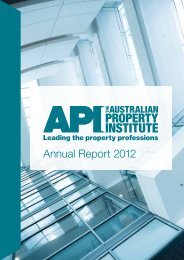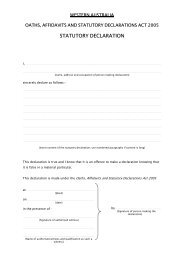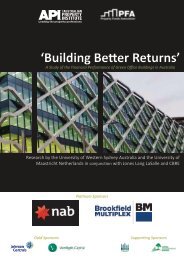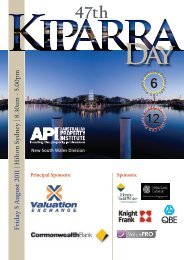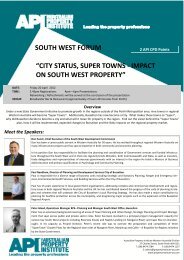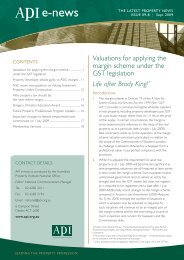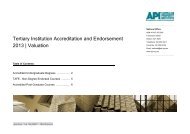VALUATIONS FOR INSURANCE PURPOSES
VALUATIONS FOR INSURANCE PURPOSES
VALUATIONS FOR INSURANCE PURPOSES
You also want an ePaper? Increase the reach of your titles
YUMPU automatically turns print PDFs into web optimized ePapers that Google loves.
ANZ VALUATION GUIDANCE NOTE 13<br />
settlement including foreseeable expenses such<br />
as fees associated with planning, architects,<br />
surveyors, consulting engineers, legal advisors, etc.<br />
2.7 Typical Policy Indemnity Cover<br />
Typical policies provide that in the event of any<br />
physical loss, destruction or damage, which has<br />
not been specifically excluded under the policy, the<br />
insurer will indemnify the insured in accordance<br />
with the applicable basis of settlement.<br />
The insurer will also typically indemnify the insured,<br />
in addition to the cost of rebuilding, for the<br />
following, provided the liability of the insurer does<br />
not increase beyond the limit of liability:<br />
• Fees associated with the cost of rebuilding such<br />
as those applicable to architects, surveyors,<br />
consultant engineers, legal advisors, etc.<br />
• Government fees and charges.<br />
• Costs and expenses incurred for the purpose<br />
of extinguishing a fire at or in the vicinity of<br />
the property insured and threatening to involve<br />
such property.<br />
• Costs associated with making the property safe<br />
after a loss.<br />
• Costs of replacing locks, keys or safe<br />
combinations in appropriate circumstances.<br />
• Costs and expenses necessarily incurred in<br />
respect of removal of debris.<br />
• Damage to tools and clothing belonging to<br />
Directors and employees of the Insured whilst<br />
on the Premises.<br />
• Temporary protection of undamaged property.<br />
• Temporary repairs.<br />
• Property of others for which insured is legally<br />
liable.<br />
2.8 Indemnity Value<br />
In placing the insurance cover the insured may<br />
elect to insure on an indemnity value basis.<br />
If the basis of insurance under the policy is<br />
indemnity value, or, in the event of a loss, if the<br />
insured elects not to replace/reinstate or repair the<br />
asset, then the insurer may make a payment on<br />
the basis of the indemnity value of the asset(s) at<br />
the time of the loss.<br />
Indemnity value is typically defined as follows:<br />
The cost necessary to replace, repair and or<br />
rebuild the asset insured to a condition and<br />
extent substantially equal to but not better or<br />
more extensive than its condition and extent<br />
at the time that the damage occurred, taking<br />
into consideration the age, condition and<br />
remaining useful life of the asset.<br />
2.9 Reinstatement Cost<br />
Reinstatement cost is typically defined as follows:<br />
Where property is lost or destroyed, in the<br />
case of a building, the rebuilding thereof, or<br />
in the case of property other than a building,<br />
the replacement thereof by similar property<br />
in either case in a condition equal to, but not<br />
better or more extensive than its condition<br />
when new.<br />
Where property is damaged: the repair of<br />
the damage and restoration of the damaged<br />
portion of the property to a condition<br />
substantially the same as, but not better or<br />
more extensive than its condition when new.<br />
Members should ensure that the valuation does<br />
not give rise to betterment. That is, the valuation<br />
should not be based on a more substantial or<br />
superior property than that which existed when<br />
the property was new<br />
2.10 Extra Cost of Reinstatement<br />
Policies for buildings and site improvements<br />
typically extend to include the extra cost of<br />
reinstatement of damaged property to comply with<br />
the requirements of building regulations in place at<br />
the time the loss occurs.<br />
This extension is typically subject to the following<br />
provision:<br />
The amount of the claim cannot include the<br />
cost of complying with a requirement which<br />
existed prior to the loss occurring and with<br />
which the insured was required to comply.<br />
As a general rule the insurer will only insure the<br />
assets as they exist, not as they may be replaced.<br />
The reason for this is the incidence of a partial loss<br />
where repairs are made to the existing structure.<br />
However, it may not be possible to reinstate an<br />
existing structure following a loss because it no<br />
longer complies with current building and fire<br />
regulations or other statutory encumbrances.<br />
Insurers therefore allow the insured to insure for<br />
the extra costs associated with complying with<br />
these regulations.<br />
ANZVGN 13 <strong>VALUATIONS</strong> <strong>FOR</strong> <strong>INSURANCE</strong> <strong>PURPOSES</strong><br />
8.13.3



